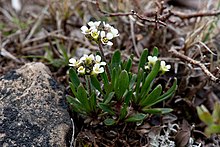
Iris lacustris, the dwarf lake iris, is a plant species in the genus Iris, subgenus Limniris and in the section Lophiris. It is a rhizomatous, beardless perennial plant, native to the Great Lakes region of eastern North America. It has lavender blue or violet-blue flowers, a very short stem and long fan-like green leaves. It is cultivated as an ornamental plant in temperate regions. It is closely related to Iris cristata.

Newfoundland and Labrador is the easternmost province in Canada. The Strait of Belle Isle separates the province into two geographical divisions, Labrador and the island of Newfoundland. The province also includes over seven thousand small islands.

Grevillea acanthifolia, commonly known as the Acanthus-leaved grevillea, is a plant in the family Proteaceae and is endemic to New South Wales. It is a shrub with stiff, prickly, divided leaves and pink to purple "toothbrush" flowers.

Anacolosa densiflora is a species of plant in the Olacaceae family. Currently, it is an endangered species that is endemic to India.

Paphiopedilum fowliei is a species of plant in the family Orchidaceae. It is endemic to Palawan in the Philippines. Its natural habitat is subtropical or tropical moist lowland forests. It is threatened by habitat loss.

Verticordia helichrysantha, commonly known as coast featherflower or Barrens featherflower, is a flowering plant in the myrtle family, Myrtaceae and is endemic to the south-west of Western Australia. It is a small, woody, open-branched shrub with crowded, linear leaves and small yellow flowers from May to September.
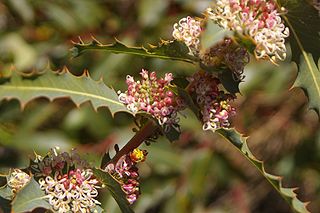
Hakea amplexicaulis, commonly known as prickly hakea, is a shrub endemic to south west Western Australia. An attractive small shrub with unusual stem clasping, sharply serrated foliage and a profusion of sweetly scented variable coloured flowers from late winter to spring.

Astragalus albens is a species of milkvetch known by the common names Cushenbury milkvetch and silvery-white milkvetch.
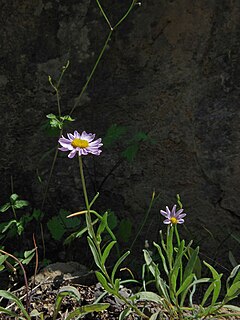
Erigeron maniopotamicus is a rare species of flowering plant in the aster family known by the common name Mad River fleabane. It is endemic to northwestern California, where it is known from only four locations in Humboldt and Trinity Counties.

Eriogonum callistum is a rare species of wild buckwheat, known by the common name Tehachapi buckwheat.
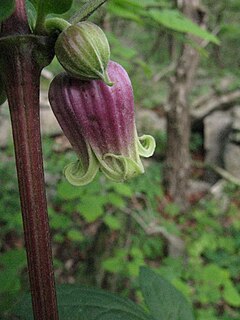
Clematis morefieldii is a rare species of flowering plant in the buttercup family known by the common names Morefield's leather flower and Huntsville vasevine.
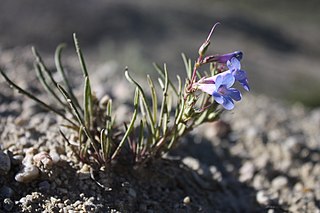
Penstemon penlandii is a rare species of flowering plant in the plantain family known by the common names Penland penstemon and Penland's beardtongue. It is endemic to Colorado in the United States, where it is known only from a strip of land about five miles long in central Grand County. There are two occurrences totalling about 8600 individuals. This is a federally listed endangered species of the United States.

Sclerocactus wetlandicus is a rare species of cactus known by the common name Uinta Basin hookless cactus. It is endemic to Utah in the United States, where it is known only from the Uinta Basin. It may also be called the Pariette cactus, but this name is more appropriate for Sclerocactus brevispinus, the species endemic to the Pariette Draw of Duchesne County.
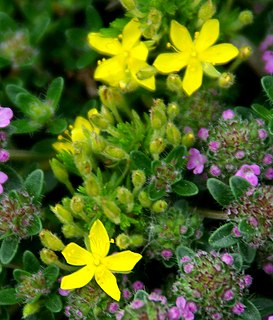
Hudsonia ericoides is a species of flowering plant in the rock-rose family known by the common names pine barren goldenheather, false heather, and golden-heather. It is native to eastern North America, where its distribution extends down the east coast from Newfoundland to Delaware, with a disjunct population in South Carolina.

Braya pilosa is a long-lived perennial flowering plant of the mustard family known by the common name hairy braya. It has one to many stems 4–12 cm long, erect to ascending to almost prostrate and moderately to densely hairy, and can be distinguished from other Braya species by its large flowers and globose fruits with very long styles. The plant arises from a tuft of basal leaves, with white flowers arranged in dense clusters. Its range is limited to the unglaciated portions of Cape Bathurst and Baillie Islands on the shore of the Beaufort Sea in the Northwest Territories, and it is listed at G2 - imperiled by NatureServe and endangered by the Committee on the Status of Endangered Wildlife in Canada (COSEWIC). Its chief threats are loss of habitat through rapid coastal erosion and saline wash from storm surges, and by melting permafrost.
Verticordia pityrhops, commonly known as East Mount Barren featherflower or pine-like featherflower, is a flowering plant in the myrtle family, Myrtaceae and is endemic to the south-west of Western Australia. It is a single-stemmed shrub which is densely-branched with crowded narrow linear leaves giving the impression of a miniature pine tree. When it flowers in autumn, the shrub is completely covered with masses of very small, honey-scented, pinkish-purple flowers.
Iris damascena is a species of plant in the genus Iris. It is a rhizomatous perennial endemic to Mount Qasioun in Syria. It has thin, sickle-shaped, grey-green leaves and medium-sized stem that holds 1-2 large flowers between March and April. Inflorescences are white or grey-white with purple-brown spotting or veining and a small blackish or dark purple signal patch with a sparse, purple or dark purple beard. It is rarely cultivated as an ornamental plant in temperate regions, as it needs very dry conditions during the summer. The species is classified as critically endangered by the IUCN.

Jankaea is a monotypic genus of flowering plants in the family Gesneriaceae. The only member of this genus, Jankaea heldreichii, is endemic to Mount Olympus in Greece where it is a relict species from the tertiary period.
Salix jejuna, the barrens willow, is a tiny willow restricted to a 30 km stretch of coastal barren lands of the Strait of Belle Isle on the Great Northern Peninsula of Newfoundland. It was first found in Labrador by Archibald Gowanlock Huntsman in 1923 and then by Merritt Lyndon Fernald, Karl McKay Wiegand, and Long in 1925. It grows in highly restricted limestone barrens where limestone crevices are found among thin soils that conceal fields of fissured limestone. It is characterized by small rounded leaves on short petioles growing close to the stems. The plant's growth architecture is twiggy flat mats that sprawl over the surface. Mats can extend to 30 cm in a couple of years. It flowers in late June to mid-July. Barrens willow's low-growing habit and spreading form allows it to take advantage of the sun-heated soil boundary and persist in harsh conditions including wind, wind-entrained ice, and soil frost heaving. Like all willows, it is a pioneer species.
Protea convexa, also known as large-leaf sugarbush, is a rare flowering shrub in the genus Protea of the family Proteaceae, which is endemic to the southwestern Cape Region of South Africa.
